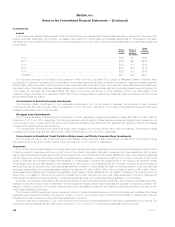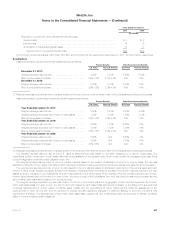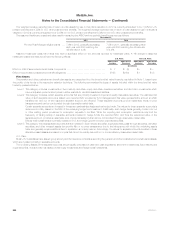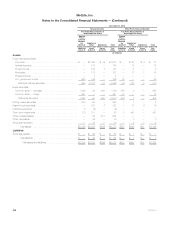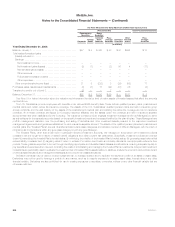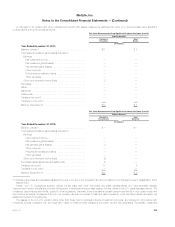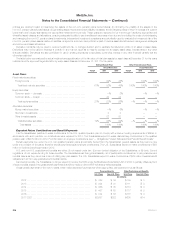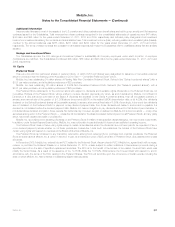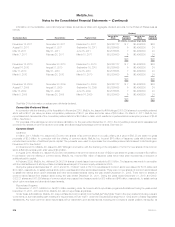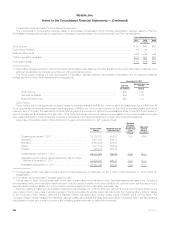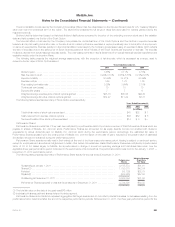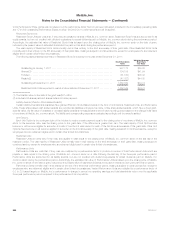MetLife 2011 Annual Report Download - page 216
Download and view the complete annual report
Please find page 216 of the 2011 MetLife annual report below. You can navigate through the pages in the report by either clicking on the pages listed below, or by using the keyword search tool below to find specific information within the annual report.
MetLife, Inc.
Notes to the Consolidated Financial Statements — (Continued)
Fair Value Measurements Using Significant Unobservable Inputs (Level 3)
Pension Benefits Other Postretirement Benefits
Fixed Maturity
Securities: Equity
Securities:
Pass-
Through
Securities Derivative
Securities
Other
Invested
Assets
Pass-
Through
SecuritiesCorporate Foreign
Bonds
Common
Stock
Domestic
(In millions)
Year Ended December 31, 2009:
Balance, January 1, .................................... $57 $ 4 $460 $80 $40 $392 $ 13
Total realized/unrealized gains
(losses) included in: ...................................
Earnings: ...........................................
Net investment income .............................. — — — — — — —
Net investment gains (losses) ......................... (5) (1) — (2) 36 4 (17)
Net derivative gains (losses) .......................... — — — — — — —
Other revenues .................................... — — — — — — —
Policyholder benefits and claims ....................... — — — — — — —
Other expenses .................................... — — — — — — —
Other comprehensive income (loss) ...................... 21 5 (232) 8 (39) (59) 17
Purchases, sales, issuances and settlements ................ (3) (3) 13 (24) (37) 36 (4)
Transfers into and/or out of Level 3 ......................... (2) — — 7 — — —
Balance, December 31, ................................. $68 $ 5 $241 $69 $— $373 $ 9
See Note 5 for further information about the valuation techniques and inputs by level of major assets of invested assets that affect the amounts
reported above.
The U.S. Subsidiaries provide employees with benefits under various ERISA benefit plans. These include qualified pension plans, postretirement
medical plans and certain retiree life insurance coverage. The assets of the U.S. Subsidiaries’ qualified pension plans are held in insurance group
annuity contracts, and the vast majority of the assets of the postretirement medical plan and backing the retiree life coverage are held in insurance
contracts. All of these contracts are issued by Company insurance affiliates, and the assets under the contracts are held in insurance separate
accounts that have been established by the Company. The insurance contract provider engages investment management firms (“Managers”) to serve
as sub-advisors for the separate accounts based on the specific investment needs and requests identified by the plan fiduciary. These Managers have
portfolio management discretion over the purchasing and selling of securities and other investment assets pursuant to the respective investment
management agreements and guidelines established for each insurance separate account. The assets of the qualified pension plans and postretirement
medical plans (the “Invested Plans”) are well diversified across multiple asset categories and across a number of different Managers, with the intentof
minimizing risk concentrations within any given asset category or with any given Manager.
The Invested Plans, other than those held in participant directed investment accounts, are managed in accordance with investment policies
consistent with the longer-term nature of related benefit obligations and within prudent risk parameters. Specifically, investment policies are oriented
toward (i) maximizing the Invested Plan’s funded status; (ii) minimizing the volatility of the Invested Plan’s funded status; (iii) generating asset returns that
exceed liability increases; and (iv) targeting rates of return in excess of a custom benchmark and industry standards over appropriate reference time
periods. These goals are expected to be met through identifying appropriate and diversified asset classes and allocations, ensuring adequate liquidity to
pay benefits and expenses when due and controlling the costs of administering and managing the Invested Plan’s investments. Independent investment
consultants are periodically used to evaluate the investment risk of Invested Plan’s assets relative to liabilities, analyze the economic and portfolio impact
of various asset allocations and management strategies and to recommend asset allocations.
Derivative contracts may be used to reduce investment risk, to manage duration and to replicate the risk/return profile of an asset or asset class.
Derivatives may not be used to leverage a portfolio in any manner, such as to magnify exposure to an asset, asset class, interest rates or any other
financial variable. Derivatives are also prohibited for use in creating exposures to securities, currencies, indices or any other financial variable that are
otherwise restricted.
212 MetLife, Inc.


